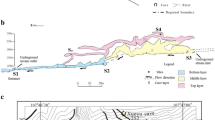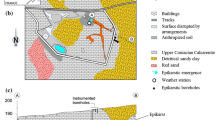Abstract
Cave CO2 is an important part of the carbon cycle in a karst system. From 2008 to 2009 the partial pressure of CO2 (PCO2) of the cave air and cave water (cave stream and dripwater) in Xueyu Cave was studied. The PCO2 for cave air and cave water over two years showed that CO2 concentrations vary seasonally in all field sites, with higher CO2 concentrations in the wet season and lower concentrations in the dry season. These seasonal CO2 variations of cave air and cave water are attributed to seasonally variable soil CO2 production that is controlled by outside temperature fluctuations. Cave ventilation controls synchronous sharp variations of PCO2 from wet season to dry season or dry season to wet season in cave water and cave air. In the wet season, there were no obvious spatial differences of mean PCO2 in cave stream and cave air from upstream to downstream cave. Conversely, there were significant spatial differences of mean PCO2 in cave stream and cave air from upstream to downstream cave in the dry season because of cave ventilation. Mean dripwater PCO2 in D1 site where near cave entrance is much higher than that of the D2 and D3 sites where located in inner cave because D1 has a shorter flowpath from cave ceiling to soda-straw tip and lesser CO2 degassing along the flowpath. Further work in Xueyu Cave needs to clarify the quantitative relationship of CO2 cycle between cave air CO2 and cave water and focus on the influence of CO2 cycle on speleothem form.





Similar content being viewed by others
References
Atkin OK, Edwards EJ, Loverys BR (2000) Response of root respiration to changes in temperature and its relevance to global warming. New Phytol 147:141–154
Atkinson TC (1977) Carbon dioxide in the atmosphere of the unsaturated zone: an important control of groundwater hardness in limestones. J Hydrol 35:11–23
Baldini JUL (2010) Cave atmosphere controls on stalagmite growth rate and palaeoclimate records. In: Pedley HM, Rogerson M (eds) Tufas and speleothems: unravelling the microbial and physical controls, vol 336. Geological Society Special Publications, London, pp 283–294
Baldini JUL, Baldini LM, McDermott F, Clipson N (2006) Carbon dioxide sources, sinks, and spatial variability in shallow temperate zone caves: evidence from Ballynamintra Cave, Ireland. J Cave Karst Stud 68:4–11
Baldini JUL, McDermott F, Hoffmann DL, Richards DA, Clipson N (2008) Very-high frequency and seasonal cave atmosphere PCO2 variability: implications for stalagmite growth and oxygen isotope-based paleoclimate records. Earth Planet Sci Lett 272:118–129
Bourges F, Genthon P, Genty D, Mangin A, Hulst D et al (2012) DCommenton ‘‘Carbon uptake by karsts in the Houzhai Basin, southwest China’’ by Junhua Yan et al. J Geophys Res 117:G03006. doi:10.1029/2012JG001937
Breecker DO, Payne AE, Quade J, Banner JL, Ball CE, Meyer KW, Cowan BD (2012) The sources and sinks of CO2 in caves under mixed woodland and grassland vegetation. Geochim Cosmochim Acta 96:230–246
Cowan BD, Osborne MC, Banner JL (2013) Temporal variability of cave air CO2 in central Texas. J Cave Karst Stud 75:38–50
de Montety V, Martin JB, Cohen MJ, Foster C, Kurz MJ (2011) Influence of diel biogeochemical cycles on carbonate equilibrium in a karst river. Chem Geol 283:31–43
Dreybrodt W (1999) Chemical kinetics, speleothem growth and climate. Boreas 28:347–356
Fairchild IJ, Baker A (2012) Speleothem Science: from process to past environments. Wiley-Blackwell, Oxford
Fairchild IJ, McMillan EA (2007) Speleothems as indicators of wet and dry periods. Int J Speleol 36:69–74
Fairchild IJ, Borsato A, Tooth AF, Frisia S, Hawkesworth CJ, Huang Y, McDermott F, Spiro B (2000) Controls on trace element Sr–Mg compositions of carbonate cave waters: implications for speleothem climatic records. Chem Geol 166:255–269
Fairchild IJ, Smith CL, Baker A, Fuller L, Spötl C, Mattey D, McDermott F, E.I.M.F (2006) Modification and preservation of environmental signals in speleothems. Earth Sci Rev 75:105–153
Falkowski P, Scholes RJ, Boyle E, Canadell J, Canfield D, Elser J, Gruber N, Hibbard K, Högberg P, Linder S, Mackenzie FT, Moore B III, Pedersen T, Rosenthal Y, Seitzinger S, Smetacek V, Steffen W (2000) The global carbon cycle: a test of our knowledge of earth as a system. Science 290:291–296
Fernandez-Cortes A, Sanchez-Moral S, Cuezva S, Cañaveras JC, Abella R (2009) Annual and transient signatures of gas exchange and transport in the Castañar de Ibor cave (Spain). Int J Speleol 38:153–162
Ford D, Williams P (2007) Karst hydrogeology and geomorphology. Wiley, Chichester, p 562
Frisia S, Fairchild IJ, Fohlmeister J, Miorandi R, Spötl C, Borsato A (2011) Carbon mass-balance modelling and carbon isotope exchange processes in dynamic caves. Geochim Cosmochim Acta 75:380–400
Gombert P (2002) Rolf of karstic dissolution in global carbon cycle. Global Planet Change 32:177–184
Guenet B, Lenhart K, Leloup J, Giusti-Miller S, Pouteau V, Mora P, Nunan N, Abbadie L (2012) The impact of long-term CO2 enrichment and moisture levels on soil microbial community structure and enzyme activities. Geoderma 170:331–336
Halbert EJM (1982) Evaluation of carbon dioxide and oxygen data in atmosphere using the Gibbs Triangle and Cave Air Index. Helictite 20:60–68
Holland HD, Kirsipu TV, Huebner JS, Oxburgh UM (1964) On some aspects of the evolution of cave waters. J Geol 72:36–67
Joe Lambert W, Aharon P (2011) Controls on dissolved inorganic carbon and δ13C in cave waters from DeSoto Caverns: implications for speleothem δ13C assessments. Geochim Cosmochim Acta 75:753–768
Kowalski AS, Serrano-Ortiz P, Janssens IA, Sánchez-Moral S, Cuezva S, Domingo F, Were A, Alados-Arboledas L (2008) Can flux tower research neglect geochemical CO2 exchange? Agric For Meteorol 148:1045–1054
Liñán C, Vadillo I, Carrasco F (2008) Carbon dioxide concentration in air within the Nerja Cave (Malaga, Andalusia, Spain). Int J Speleol 37:99–106
Liu Z, Zhao J (2000) Contribution of carbonate rock weathering to the atmospheric CO2 sink. Environ Geol 39:1053–1058
Liu Z, Li Q, Sun H, Wang J (2007) Seasonal, diurnal and storm − scale hydrochemical variations of typical epikarst springs in subtropical karst areas of SW China: soil CO2 and dilution effects. J Hydrol 337:207–223
Liu Z, Dreybrodt W, Wang H (2010) A new direction in effective accounting for the atmospheric CO2 budget: considering the combined action of carbonate dissolution, the global water cycle and photosynthetic uptake of DIC by aquatic organisms. Earth Sci Rev 99:162–172
Mandić M, Mihevc A, Leis A, Bronić KI (2013) Concentration and stable carbon isotopic composition of CO2 in cave air of Postojnska jama, Slovenia. Int J Speleol 42:279–287
Martin J (2017) Carbonate minerals in the global carbon cycle. Chem Geol 449:58–72
Mattey DP, Fairchild IJ, Atkinson TC, Latin JP, Ainsworth M, Durell R (2010) Seasonal microclimate control of calcite fabrics, stable isotopes and trace elements in modern speleothem from St Michaels cave, Gibraltar. J Geol Soc 336:323–344
McDonald J, Drysdale R, Hill D, Chisari R, Wong H (2007) The hydrochemical response of cave drip waters to sub-annual and inter-annual climate variability, Wombeyan Caves, SE Australia. Chem Geol 244:605–623
Peyraube N, Lastennet R, Denis A (2012) Geochemical evolution of groundwater in the unsaturated zone of a karstic massif, using the PCO2-SIc relationship. J Hydrol 430:13–24
Peyraube N, Lastennet R, Denis A, Malaurent P (2013) Estimation of epikarst air Pco2 using measurements of water δ13CTDIC, cave air Pco2 and δ13Cco2. Geochim Cosmochim Acta 118:1–17
Pu J, Shen L, Wang A, He Q, Yuan W, Hu Z, Chen B, He Y (2007) Space-time variation of hydro-geochemistry index of the Xueyu cave system in Fengdu County, Chongqing. Carsologica Sin 28:49–54
Pu J, Yuan D, Zhao H, Shen L (2014) Hydrochemical and PCO2 variations of a cave stream in a subtropical karst area, Chongqing, SW China: piston effects, dilution effects, soil CO2 and buffer effects. Environ Earth Sci 71:4039–4049
Pu J, Wang A, Yin J, Shen L, Sun Y, Yuan D, Zhao H (2015) Processes controlling dripwater hydrochemistry variations in Xueyu Cave, SW China: implications for speleothem palaeoclimate signal interpretations. Boreas 44:603–617
Pu J, Wang A, Shen L, Yin J, Yuan D, Zhao H (2016) Factors controlling the growth rate, carbon and oxygen isotope variation in modern calcite precipitation in a subtropical cave, Southwest China. J Asian Earth Sci 119:167–178
Pu J, Li J, Khadka M, Martin J, Zhang T, Yu S, Yuan D (2017) In-stream metabolism and atmospheric carbon sequestration in a groundwater-fed karst stream. Sci Total Environ 579:1343–1355
Šebela S, Prelovšek M, Turk J (2013) Impact of peak period visits on the Postojna Cave (Slovenia) microclimate. Theoret Appl Climatol 111:51–64
Serrano-Ortiz P, Roland M, Sanchez-Moral S, Janssens IA, Domingo F, Goddéris Y, Kowalski AS (2010) Hidden, abiotic CO2 flows and gaseous reservoirs in the terrestrial carbon cycle: Review and perspectives. Agric For Meteorol 150:321–329
Sherwin CM, Baldini JUL (2011) Cave air and hydrological controls on prior calcite precipitation and stalagmite growth rates: implications for palaeoclimate reconstructions using speleothems. Geochim Cosmochim Acta 75:3915–3929
Tooth AF, Fairchild IJ (2003) Soil and karst aquifer hydrological controls on the geochemical evolution of speleothem-forming drip waters, Crag Cave, southwest Ireland. J Hydrol 273:51–68
Wang A, Pu J, Shen L, He Y (2010) Natural and Human Factors of CO2 Concentration Variations in Xueyu Cave, Chongqing. Trop Geogr 30:272–277
Wang X, Yin J, Xu S, Shen L (2013) The variation of soil CO2 and hydrochemistry of epikarst spring above Xueyu cave. J Soil Water Conserv 27:85–89
White WB (1988) Geomorphology and hydrology of karst terrains. Oxford University Press, New York, p 464p
Wigley TML (1977) WATSPEC: a computer program for determining equilibrium speciation of aqueous solutions. Br Geomorphol Res Group Tech Bull 20:1–48
Xu S (2013) Study on the variation of air CO2 concentration and water–gas carbon conversion in Xueyu Cave, Chongqing. M.Sc Thesis, Southwest University, pp 60
Xu S, Yin J, Wang X, Yang P, Mao H, Shen L (2012) Impact of seasonal karstfication on the precipitation rate of cave sediments: a case study of the underground river system of the Xueyu Cave, Chongqing. Trop Geogr 32:481–486
Yang R, Liu Z, Zeng C, Zhao M (2012) Response of epikarst hydrochemical changes to soil CO2 and weather conditions at Chenqi, Puding, SW China. J Hydrol 468–469:151–158
Yuan D (1997) The carbon cycle in karst. Zeitschrift Für Geomorphologie 108:91–102
Zhu X, Zhang Y, Han D, Wei R, Chen B (2004) Cave characteristics and speleothems in Xueyu Cave group, Fengdu, Chongqing city. Carsologica Sin 23:85–90
Acknowledgements
We especially thank Miss Erin Lynch for her valuable comments and text editing, which greatly improved the original manuscript. Financial support for this research was provided by National Natural Science Foundation of China (NOs. 41572234, 41202185), the Special Fund for Basic Scientific Research of Chinese Academy of Geological Sciences (NO. YYWF201636), the Key Research and Development Fund of Ministry of Science and Technology of China (NO. 2016YFC0502501), the Guangxi Natural Science Foundation (2016GXNSFCA380002), and the Geological Survey Project of CGS (DD20160305-03). Thanks are given to Shangquan Xu, Yuchuan Sun for their help with field sampling and in the laboratory.
Author information
Authors and Affiliations
Corresponding author
Rights and permissions
About this article
Cite this article
Pu, J., Wang, A., Yin, J. et al. PCO2 variations of cave air and cave water in a subtropical cave, SW China. Carbonates Evaporites 33, 477–487 (2018). https://doi.org/10.1007/s13146-017-0359-0
Accepted:
Published:
Issue Date:
DOI: https://doi.org/10.1007/s13146-017-0359-0




